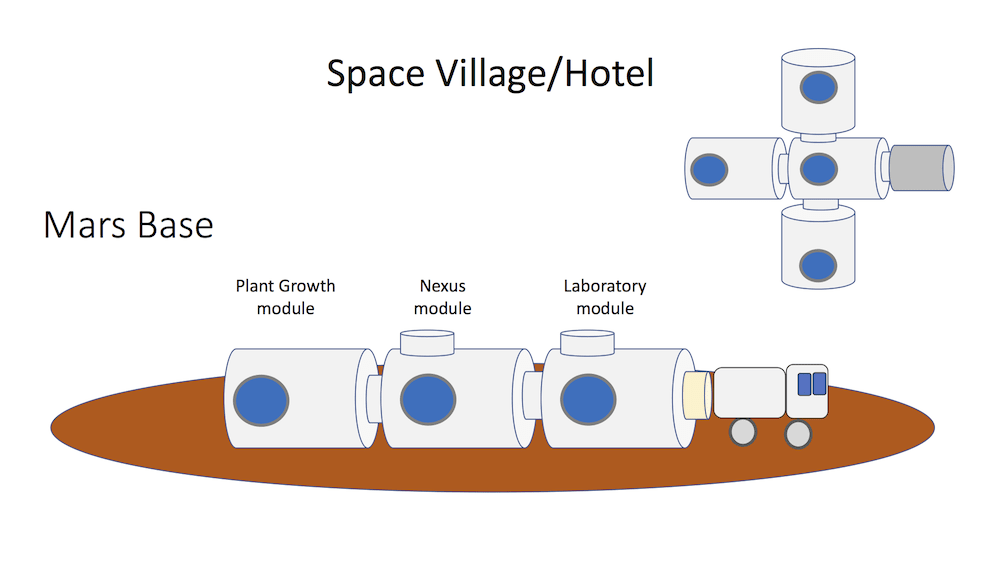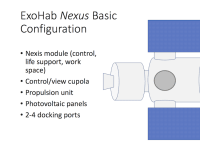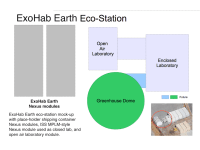ExoHab is a high-performance, sustainability ecosystem for space and Earth. The ExoHab concept is an open, plug-and-play framework for small, standalone space habitats or networks of habitats and work facilities.
At a hardware level, the ExoHab ecosystem would be built around 6.1 meter long, pressurized shells that are based upon the ISS multi-purpose logistics module (MPLM). The MPLM is space-tested hardware that is already compatible with existing space systems. The MPLM is relatively small, so that it can be launched on several rockets including the SpaceX Falcon 9 (or Heavy Thrust version for a highly loaded module).
A baseline Nexus module serves as a core habitat. Nexus can support 2 to 3 persons. It includes food, sleep and hygiene facilities. It includes rack space for control, atmosphere and water recycling facilities, food growth and experiments. There is additional space for work and storage. The Nexus can be equipped with photovoltaic cells, propulsion module and cupola. Several modules can be combined for a space research or operations center. In fact, a space hotel can be built, where additional Nexus units are used for private, self-supporting hotel rooms. Beyond Earth orbit, the Nexus and add-on modules can be used for an expandable Lunar or Martian settlement.
Two aspects of ExoHab transcend beyond traditional space facilities. Both the hardware and software will be open, plug-and-play ecosystems. In addition to the shell itself being a modular component, all of the systems will be modular and open (and designed not to violate ITAR). For example, if a company develops a better water recycling system, they can swap that in, as long as it fits into the required specifications. Synergies between components will be encouraged. This aspect was inspired by Open Source Ecology’s Global Village Construction Set.
Exohab will feature an environmental operating system (Exo-Net) that will critical resources such as energy, air and water use. Even though different companies and countries might own and operate different modules and components, every piece of an Exohab facility will need to communicate with Exo-Net which will allocate resources based on pre-existing agreements. It will literally provide an economic system for future space facilities and settlements. This will be an open-source system, so that it is transparent and anyone may contribute.
ExoHab can also be used for “sustainability stations” on Earth. Instead of an MPLM, an Earth installation could fit inside a 20 foot shipping container. The atmospheric system would be replaced by an HVAC system. However, the water recycling system would be retained to the extent financially feasible. Just as ISS minimizes power use, so too would ExoHab, so that it could be easily powered with solar wind energy. ExoHab could be used in extreme environments such as deserts (where water and fresh food are at a premium) or in certain disaster zones.
A prototype ExoHab complex was mocked up using surplus analog ISS modules at the NASA Ames Research Center, to better understand volume, logistical and environmental constraints. An initial ExoNet resource-tracking application has been written.
Like this entry?
-
About the Entrant
- Name:Mark Ciotola
- Type of entry:individual
- Software used for this entry:Ruby, Python, databases
- Patent status:none








